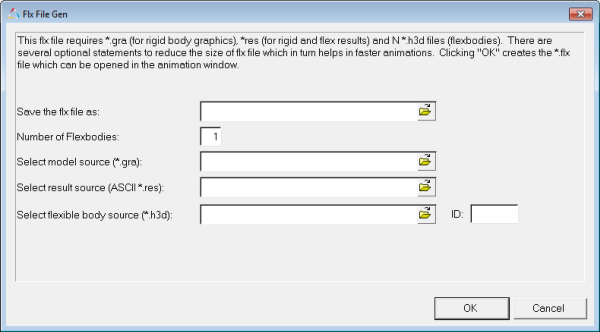Flex File Gen |

|

|

|

|
|
Flex File Gen |

|

|

|

|
The Flx File Gen dialog allows you to create an *.flx file, which is required to animate ADAMS transient or linear results that contain flexible bodies in HyperView. An .flx file requires the following files: a .gra file (for rigid body graphics), a .res file (for rigid and flex results), and an *.h3d file (for flexbodies; converted from .mnf using the Flex Prep Tool). The .h3d file contains the node and element information required to generate the flexbody graphics. After specifying the various the files, click OK to create the *.flx file (which can then be opened in HyperView for animation). From the FlexTools menu, select Flex File Gen to display the dialog.

The Flx File Gen dialog
The following fields must be populated before creating the .flx file:
Save the flx file as: |
Enter a name and select a directory to which you want to save the .flx file. |
|
Number of FlexBodies: |
Enter the number of flexbodies the file should contain. |
|
Select model source (*.gra): |
Select the model source .gra file. |
|
Select result source (ASCII *.res) |
Select the result source ASCII .res file. |
|
Select flexible body source (*.h3d): |
Select the source .h3d file. |
|
|
ID: |
The ID of the flexbody in the solver input deck. |
OK |
After making your selections, click OK to create your file. |
|
Cancel |
Exit Flx File Gen. |
|
An FLX file example:
*ModelSource("sc.gra")
*FlexSource("link.h3d", 1, 1.0), where 1 is the ID of the flexbody in the ADAMS input file(required for animation). 1.0 is the scale factor of the flexbody.
*FlexSource("link.h3d", 2, 1.0), where 2 is the ID of the flexbody in the ADAMS input file(required for animation). 1.0 is the scale factor of the flexbody.
*ResultSource("sc.res")
The .flx file is also generated automatically if MotionView's pre-processor is used to generate the ADAMS model that contains flexbodies.
See Also: